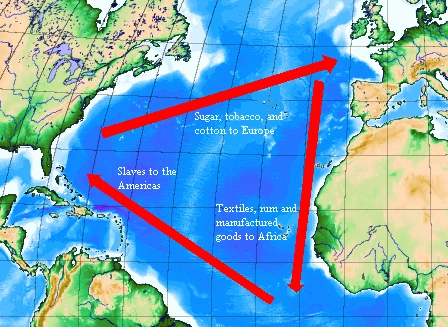The Basics Of The Triangle Trade
Triangle Trade is a concept in trade that involves three parties that have worked out a system to balance their import and export requirements. This system flourished between the 16th and 19th centuries and was associated with the slave trade.

The main components of triangle trade
The triangle trade system in general refers to a trade pattern that emerges between three nations. The three arms of exchange could be composed of:
- Raw materials and agricultural produce
- Processed/Manufactured products
- Labor/Human Resources – usually in the form of slaves
The three parties of a triangle trade each had one or more of the above components that they offered in the trade in return for another.
Historical examples
There were many examples of triangle trade such as:
- Before the American Revolutionary War, a triangular trade network emerged linking Great Britain, its North American Colonies, and the British Caribbean colonies. This trade involved the North American colonies exporting natural resources such as fish (notably salt cod), agricultural goods, and lumber to the West Indies, where these were exchanged for sugar and molasses. These Caribbean products, along with the raw materials from North America, were then transported to Great Britain, which in turn exported manufactured goods back to its colonies.
- Newfoundland’s salt cod and corn from Boston were shipped to Southern Europe in British vessels. This route also saw the return transport of European products like wine and olive oil to Britain, creating a circular exchange of goods across the Atlantic.
- In the early 19th century, a new ‘sugar triangle’ trade pattern developed. American ships would carry local produce to Cuba, where they would then load sugar or coffee to be transported to the Baltic coast, particularly to regions within the Russian Empire and Sweden. The journey concluded with these ships bringing back items such as bar iron and hemp to New England, completing the triangular trade route.
Atlantic Slave Trade
The most significant among the historical triangle trades was the Atlantic Slave Trade. The phrase “triangle trade” was first coined to refer specifically to the Atlantic Slave Trade. This trade took place between Europe, Africa, and the Americas from the 16th to 19th century. Slave ships assembled in Europe took manufactured goods, textiles, and rum to Africa and traded them over for slaves. The slaves were then put for sale in the Americas and traded for commodities like sugar, cotton, and tobacco. In the Americas, African slaves were purchased to work in the plantations of valuable crops such as cotton, sugar, and tobacco. These raw materials were in high demand in Europe and they were processed to complete the cycle of the triangle trade. Now, let’s delve deeper into each of the three legs of the Triangle Trade to understand their specific roles and dynamics.
The First leg
The goal of the first leg was to purchase slaves to overcome the labor shortage in sugar and tobacco plantations in the Caribbean and Americas.
The first leg of the triangle trade involved the Europeans sailing to the slave coast, a section of the West African coast that consists of nations today known as Togo, Benin, and Nigeria, to exchange metals, brass dishes, knives, tools, textiles, firearms, ammunition for slaves.
The Second leg (Middle Passage)
The middle passage involved a 21-90 day journey to the West Indies and Brazil to sell the slaves at auction. Due to extreme and inhumane conditions in which slaves were shipped, 10 to 20 percent of the slaves being shipped died at the middle passage. After the slaves were sold they were distributed to various plantations and other parts of the New World. The ships were then cleaned and loaded with produce from the plantations for a return journey, which was the third leg.
The Third Leg
The cargo carried in the third leg included raw materials like sugar, rice, tobacco, and cotton which were supplied to manufacturing industries in Europe. This completes the cycle and is repeated.
Although the Triangle Trade is often simplified into three distinct legs, the reality was far more complex. In practice, it involved numerous intermediate exchanges that effectively created a web of global trade networks working simultaneously.
Colonial Molasses Trade
The colonial molasses trade, a vital component of the Atlantic Slave Trade, was immensely profitable and intricately linked to the economies of multiple regions. French colonies in the West Indies, known for their abundant production of molasses, faced a deficit of essential materials like lumber, cheese, and flour. Conversely, North American colonies were rich in these raw materials but lacked access to molasses.
In this trade network, merchants from the North American colonies purchased molasses, a byproduct of sugar production, from Caribbean plantations. This molasses was then transported to New England (modern-day North America) and Europe. In these destinations, molasses was a crucial ingredient for brewing companies in the production of rum. The revenues generated from these sales were then utilized to purchase rum, which was often traded back to the West Indies in exchange for more molasses, creating a continuous cycle of trade. This cycle not only perpetuated the demand for slave labor on sugar plantations but also fostered a complex economic relationship between the colonies and European nations.
Conclusion
The Triangle Trade was a pivotal element in global history, shaping the economies, societies, and politics of Europe, Africa, and the Americas. While it spurred economic growth and the exchange of goods, it also caused profound human suffering, particularly through the Atlantic Slave Trade. Understanding this complex trade system offers insight into the historical forces that have shaped our modern world, highlighting the intertwined nature of global development and its lasting impacts.
